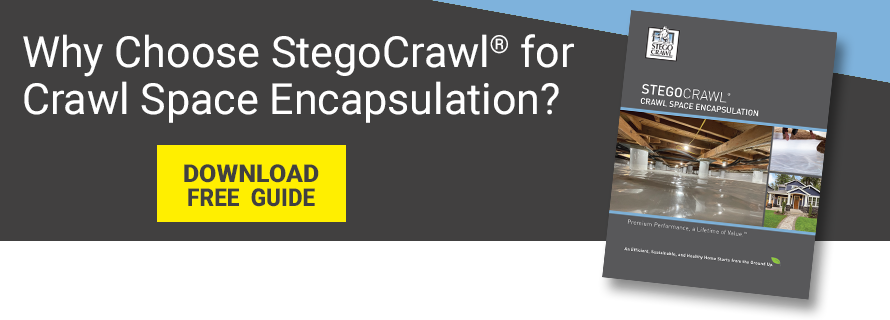Preventative Measures for Encapsulating a Crawl Space After Flooding
Whether from a natural disaster or a busted pipe, flood damage can cause major problems for your home. Crawl spaces can take the brunt of this damage, and in many cases are left completely submerged in sitting water teeming with bacteria. That’s why it’s important to implement preventative measures, ensuring that you have a properly encapsulated crawl space that will diminish the likelihood of floods causing major damage to your home.
encapsulating%20after%20flooding%20(stock%20photo).jpg?width=936&height=371&name=(featured)encapsulating%20after%20flooding%20(stock%20photo).jpg) Knowing how to recover from a flood is crucial to maintaining a clean and dry crawl space. Source: iStock
Knowing how to recover from a flood is crucial to maintaining a clean and dry crawl space. Source: iStock
However, if your crawl space has already suffered from a flood, it's important to take immediate action. You can’t go back in time and prevent flooding damage, but you can take steps to repair the damage and minimize similar problems in the future.
Types of Flood Damage to an Unconditioned Crawl Space
Crawl space flooding from natural sources usually happens when water from a heavy rain or a flood causes the water table level to rise. The moisture that accumulates in your crawl space can cause major structural damage, especially if the crawl space was previously unprotected and was already exposed to high levels of moisture. Not only this, but the presence of flood water in an unconditioned crawl space leaves it open to hazardous conditions that may affect your entire home:
- Infiltration of pests and debris: Flood waters can usher in leaves, dirt, and other debris, as well as unwanted pests such as bugs and rodents, especially in vented crawl spaces.
- Mold and mildew: Mold and mildew thrive in moisture-rich environments, and if they are already developing in an unprotected crawl space, the additional stagnant water will create a petri dish for more growth.
- Hazardous stagnant water: Stagnant water may not seem dangerous in and of itself, but it can make your household pets sick as well as rust equipment and pipes.
- Water damage to wood supports, flooring, or walls: In the event that flood waters rise high enough to reach the joists of the flooring or through capillary action rise through the concrete walls (capillary pressure is great enough that it can raise moisture through brick to a 1,000 ft elevation), they can cause the joists to rot, weakening the structural integrity of the flooring and walls.
- Crawl space erosion: A crawl space that is not encapsulated and has no protective covering on the floors and walls will be left susceptible to erosion. This can be hazardous to the foundation of the entire home.
- Existing vapor barrier may trap water in crawl space: If the crawl space has a vapor barrier that is not properly sealed, it could allow the migration of water through the seams of the barrier, and without a properly functioning dehumidification system, could trap standing water on the top side of your crawl space liner where it can’t reabsorb back into the ground.
Enclosing a Crawl Space After a Flood
It is clear that a properly encapsulated crawl space is the best solution for preventing mold, pests, and improving the overall air quality for your home. But how do you install a vapor barrier after flood damage? There are several steps you’ll need to take before you can safely enclose your crawl space. These are:
- Stop flooding, drain with sump pump: If the flood was caused by a busted water pipe, fixing the piping takes precedence over everything else. Once the flooding has stopped and you have assessed the areas where the water has collected, you should begin pumping the water out with a sump pump designed to be submerged in water. Make sure the pipe or hose channeling the water outside is far enough away from the crawl space that the water can’t drain right back in.
- Fix any pipes that may leak in the future: In addition to stopping the pipe that caused the flood, all other piping should be observed for any leaks or breaks caused by the flood. Standing water can also cause piping to rust, which weakens the material and eventually will cause leaks and breakage. These should be assessed for damage and repaired prior to continuing with the crawl space encapsulation.
- Clear crawl space of debris, pests: Cleaning out any debris or pests seems intuitive, but also remember to check for termites that may find their way in. Dirt and mud can also accumulate after the water is pumped out and should be removed, especially from around piping or ductwork.
- Confirm if there is any structural damage and mold: Have a professional inspect the crawl space for any potential structural damage to joists or mold growth. This is especially important the longer the water has had to sit in the crawl space. If they find problems, you may need to have repairs done to reinforce the framework and/or remove any mold or mildew that has accumulated.
- Consult an expert to determine the correct procedure: Once the crawl space has been cleared and inspected for damage, consult a vapor barrier supplier or contractor about enclosing your crawl space, especially if you plan on completing the project yourself. Smart homeowners will invest in complete encapsulation and conditioning of their crawl space, verifying that a high-quality vapor barrier is installed and that all penetrations are properly sealed.
What To Make Sure Your Contractor Knows
It is not uncommon for contractors or flood restoration experts to suggest treating your crawl space for mold and some even claim this treatment alone will prevent the return of mold growth. In reality, without completely drying out, closing, encapsulating and conditioning a crawl space after treating it for mold, the conditions that led to mold in the first place haven’t been eliminated, and you’ll have to deal with it all over again in the future.
You may not be able to control when a flood will cause damage to your home’s crawl space, but you can control your response. Acting quickly, asking the right questions, and using the highest quality products available will help mitigate any damage and prevent complications further down the road.

Written by Tom Marks
Tom Marks is the Business Development Project Manager with Stego Industries, LLC. He has been with Stego since 2007, serving many years as the Rocky Mountains Regional Manager. Now, his focus is geared toward vapor barrier solutions for new and existing homes as the Product Manager of the StegoHome and StegoCrawl brands. In addition, Tom serves as Sustainability Manager, overseeing Stego’s leadership in holistic product and corporate sustainability. Tom enjoys working with a wide range of project team members and customers to incorporate effective sub-slab vapor protection and create healthy, sustainable homes and buildings.
- Stego (26)
- StegoCrawl (24)
- Stego-Awareness (17)
- StegoHome (15)
- Case Studies (14)
- StegoCrawl-Consideration (12)
- StegoCrawl-Awareness (11)
- Customer Stories (9)
- Stego-Consideration (9)
- Pango (8)
- StegoHome-Consideration (8)
- Beast (7)
- How to Install (7)
- StegoHome-Awareness (7)
- Drago (5)
- Pango-Awareness (5)
- Beast-Awareness (4)
- Beast-Consideration (3)
- Drago-Awareness (3)
- Pango-Consideration (3)
- Stego IQ (3)
- Drago-Consideration (2)
- StegoCrawl-Decision (2)
Popular Posts
Stay Connected.
Enter your email below.







Post Comments